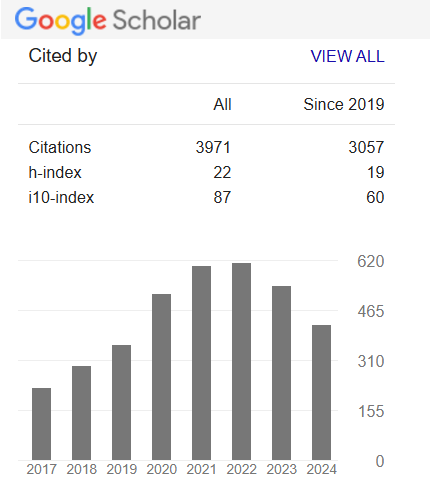Control of penicillium expansum Link Causing Blue Mold of Pear Using Some Fungicides
Keywords:
Pear, blue mold, Penicillium expansum, carbendazim resistant, fungicidesAbstract
Blue mold of pear is caused by Penicillium expansum Link. Thom. ex. is one of the most serious post harvest disease in India. Total twenty three isolates of P. expansum were isolated from infected pear fruits for sensitivity tested against carbendazim on Potato Dextrose Agar (PDA) medium. Sensitivity of these isolates to carbendazim was determined using food poisoning method. In vitro Minimum Inhibition Concentration (MIC) for carbendazim was determined; isolate Pe-9 MIC-750.6μg/ml was sensitive while isolate Pe-15 MIC-970.3 μg/ml was tolerant. In vivo Pe-9 MIC-1900.2μg/ml was sensitive. Pe-15 MIC-2470.3μg/ml was tolerant. Carbendazim resistant mutant (Pe-EMS-10, MIC-4850.6μg/ml) is equally important to manage using different fungicides. P. expansum was tested against carbendazim and other fungicides viz. dithane Z-78, polyram, acrobat, kocide, dithiocarbmate, thiobendazole and diphenylamine. In vitro results revealed that the Percentage Control Efficacy (PCE) values range at 50% Conc. (44.02 - 49.28%) while at 100% Conc. (50.89 - 61.39%) individually and in mixture with carbendazim increased its PCE from at 50% Conc. (55.39 - 68.98%) while at 100% (68.72 -73.57%). In vivo PCE at 50% Conc. (51.62 - 56.95%) individual and mixture (57.25 - 59.26%) while at 100% from alone (58.32 - 69.36%) and in mixture (71.63 - 79.82%) PCE further increased and without fungicide served as control.
Downloads
References
Abdelfettah Maouni, Ahmed Lamarti, Anouar Aidoun, Mustapha Kaddor and Alain Badoc (2007) Effect of benzimidazole fungicides and calcium chloride on Alternaria alternata and Penicillium expansum rot during storage of pears. African journal of Biotechnology Vol. 6(11) pp 1289-1292.
Amrani N and Najiim L (1985) Contribution to study of microscopical fungal of Morrocco.2. Alternaria alternate, microsclerotia and chlamydospores cryptogam, Journal of Mycology 6: 265-270.
Blacharski R W, Bartz JA, Xiao CL and Legard DE (2001) Control of post harvest Botrytis fruit rot with preharvest fungicide applications in annual strawberry. Plant Disease 85: 597-602.
Chamorn Manreet and Yasujoshi Hayata (2006) Antifungal activity of Tio2 Photo catalysis against Penicillium expansum in vitro and in fruit tests. International J. of Food Microbiology. 107: 666-668.
Cohen E (1989) Evaluation of fenpropimorph and flutriafol for control of sour rot, blue and green mold in lemon fruits. Plant Disease. 73: 807-809.
Dahiwale M and Suryawanshi N S (2011) Integrated management of carbendazim resistant Alternaria alternata. Life Sci. journal Bioinfolet. 8(1): 67-68.
Hassani EL (1991) Influence des traitements chimiques au Drencher sur l’incidence des pourritures a Penicillium expansum sur poires en conservation.Memoire de 3e cycle, IAVHassan II of Rabat, Morrocco.
Forster B and Staub T (1996) Basis for use strategies of anilinopyrimidin and phenylpyrrole fungicides against Botrytis cenerea. Crop Protection 15: 529-537.
Gangawane LV (1981) Fungicide Resistant in crop protection. Journal of Pesticides 15(11): 12-16.
Goepfert JM (1980) Verduras, hortalizas, frutas, frutos secos y susproductos Ch.21. pp 335–338. In: Ecología Microbiana de los Alimentos,Vol II. Ed. Acribia, Zaragoza, Espana.
Koffmann and Penrose LJ (2003) Fungicide for the blue mould (Penicillium Spp.) in pome fruits. Scientia Horti 31(3-4) 225-232.
Latorre BA, Lillo C, and Rioja ME (2001) Eficacia de los tretamientos fungicidas para el control de Botrytis cenerea de la vid en function de laepoca de application. Cien. Inv. Agr. 28:61-66.
Maouni A, Lamarti A, Douira and Badoc A (2002) Etude de la ressistance d Alternaria alternate et Penicillium expansum aux fungicides lors de la conservation des poires. Bull.Soc. Pharm. Bord 141: 61-72.
Dahiwale MA, Baviskar RN and Suryawanshi NS (2009) Integrated Management of Alternaria alternata causing fruit rot of Pomegranate. Journal of Bioinfolet 6(1): 44-45.
Dahiwale MA and NS Suryawanshi (2010) Integrated Management of Carbendazim Resistant Alternaria alternata using Homoeopathic medicines. Journal of Bioinfolet 3(2) 330-331.
Nene Y L and Thapliyal P N (1992) Fungicide in plant disease control. Oxford and IBH Publ.Co. Pvt. New Delhi. 212-349.
Ramdani A (1989) Les pourritres a Penicillium expansum Link ex. Thom. Des pommes et des poires dans une station frigorifique de la region de Meknes: Problemes et remedes. Memorie de 3e cycle, IAV Hassan II of Rabat, morocco.
Selmaoui K and Douira A (1999) Microscelerotia Alternaria alternata. J. Phytophol. Mediterr. 38: 43-46.
Staub T and Sozzi D (1984) Fungicide resistant. Plant Diseases. 68: 1026-1031.
Wedge DE, Smith BJ, Quebedeaux JP and Constantin RJ ( 2007) Fungicide management strategies for control of strawberry fruit rot diseases in louisiana and Mississippi. Crop Protection 26: 1449-1458.
Wicks T (1977) Tolerance to benzimidazole fungicide in blue mold (Penicillium expansum) on pears. Plant Dis. Rep. 61: 447-449.
Downloads
Published
How to Cite
Issue
Section
License
Copyright (c) 2016 Authors

This work is licensed under a Creative Commons Attribution-NonCommercial-NoDerivatives 4.0 International License.
Open Access This article is licensed under a Creative Commons Attribution 4.0 International License, which permits use, sharing, adaptation, distribution and reproduction in any medium or format, as long as you give appropriate credit to the original author(s) and the source, provide a link to the Creative Commons license, and indicate if changes were made. The images or other third party material in this article are included in the article’s Creative Commons license unless indicated otherwise in a credit line to the material. If the material is not included in the article’s Creative Commons license and your intended use is not permitted by statutory regulation or exceeds the permitted use, you will need to obtain permission directly from the copyright holder. To view a copy of this license, visit http://creativecommons.org/ licenses/by/4.0/










